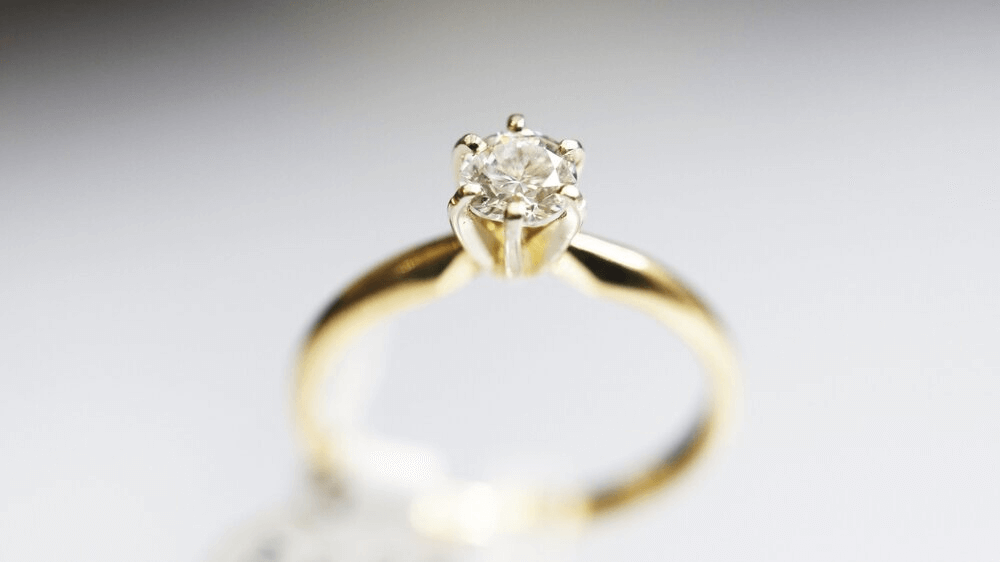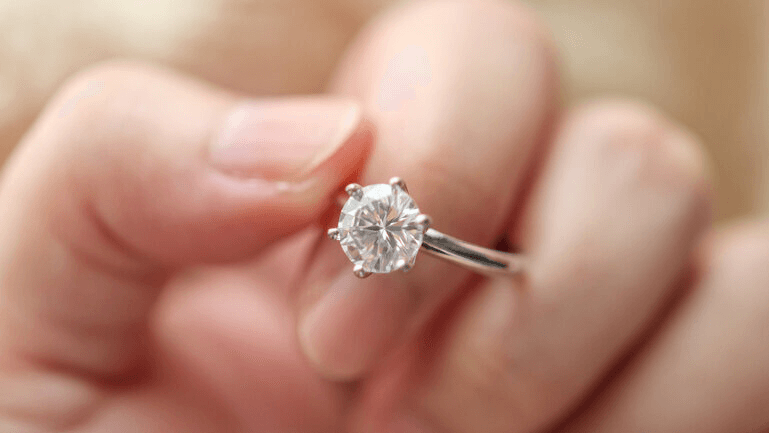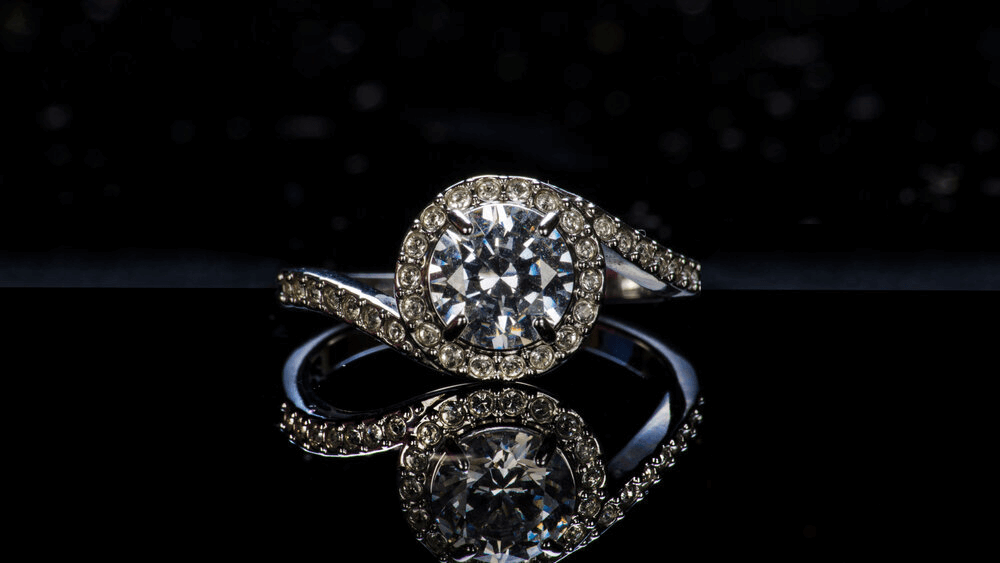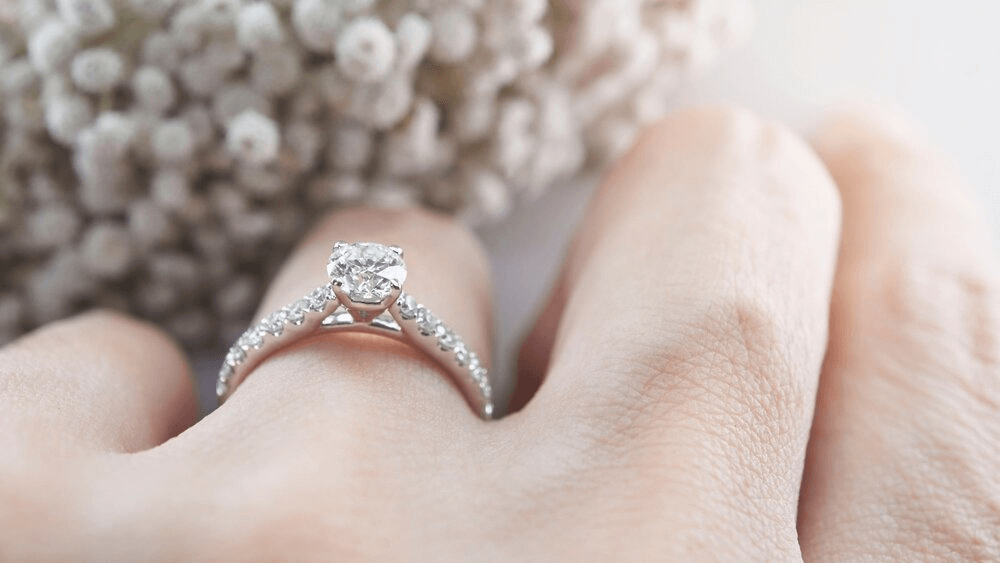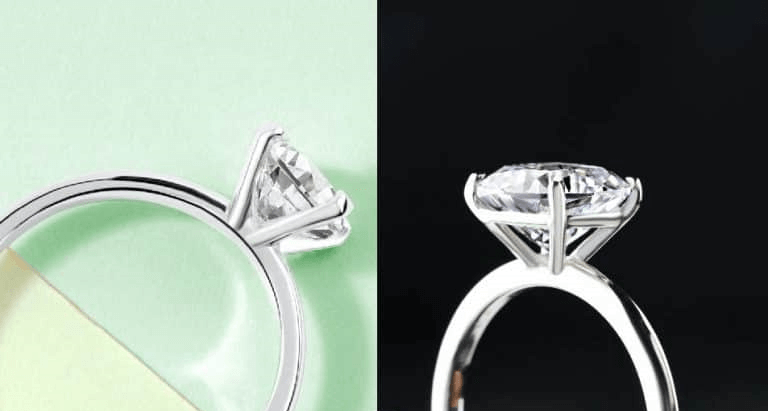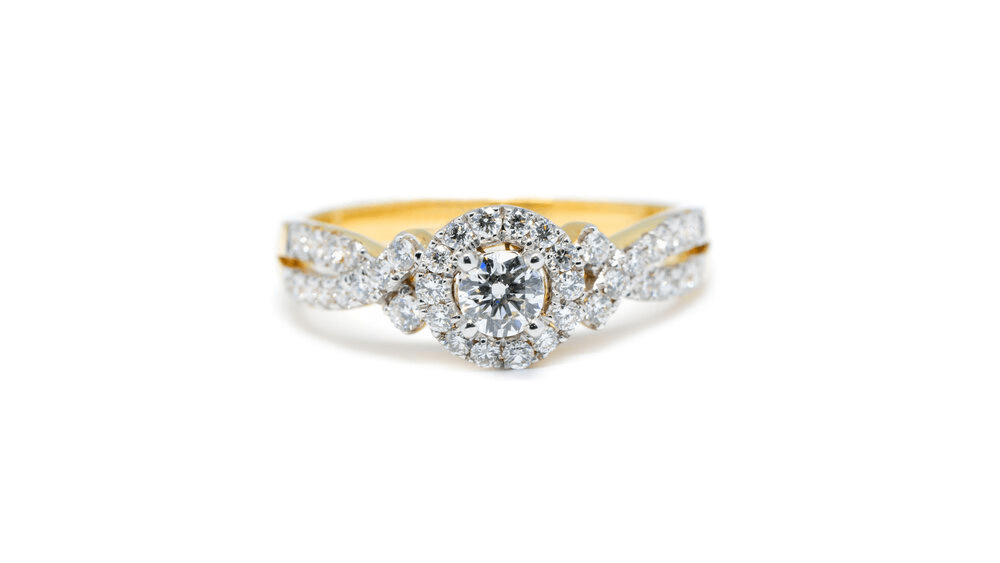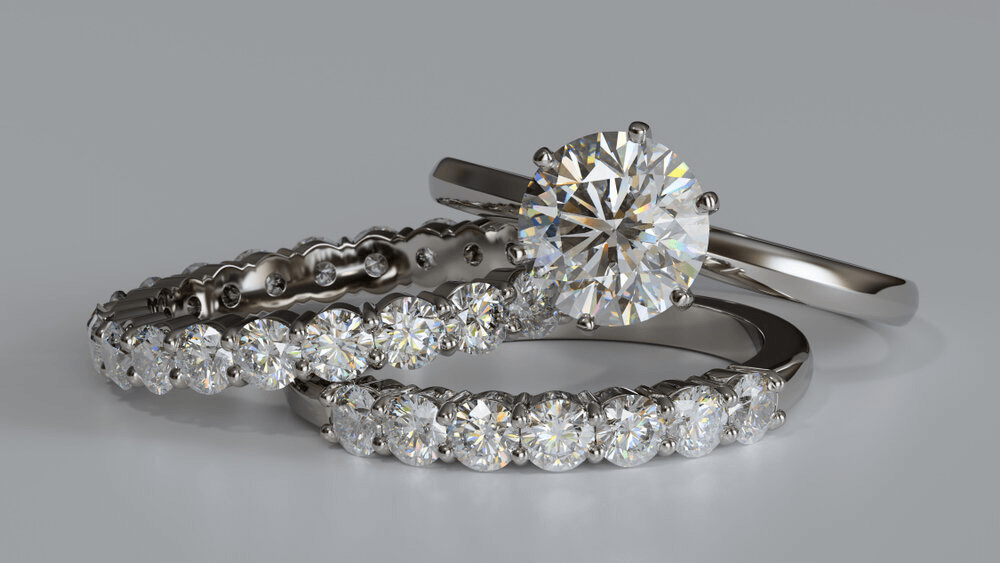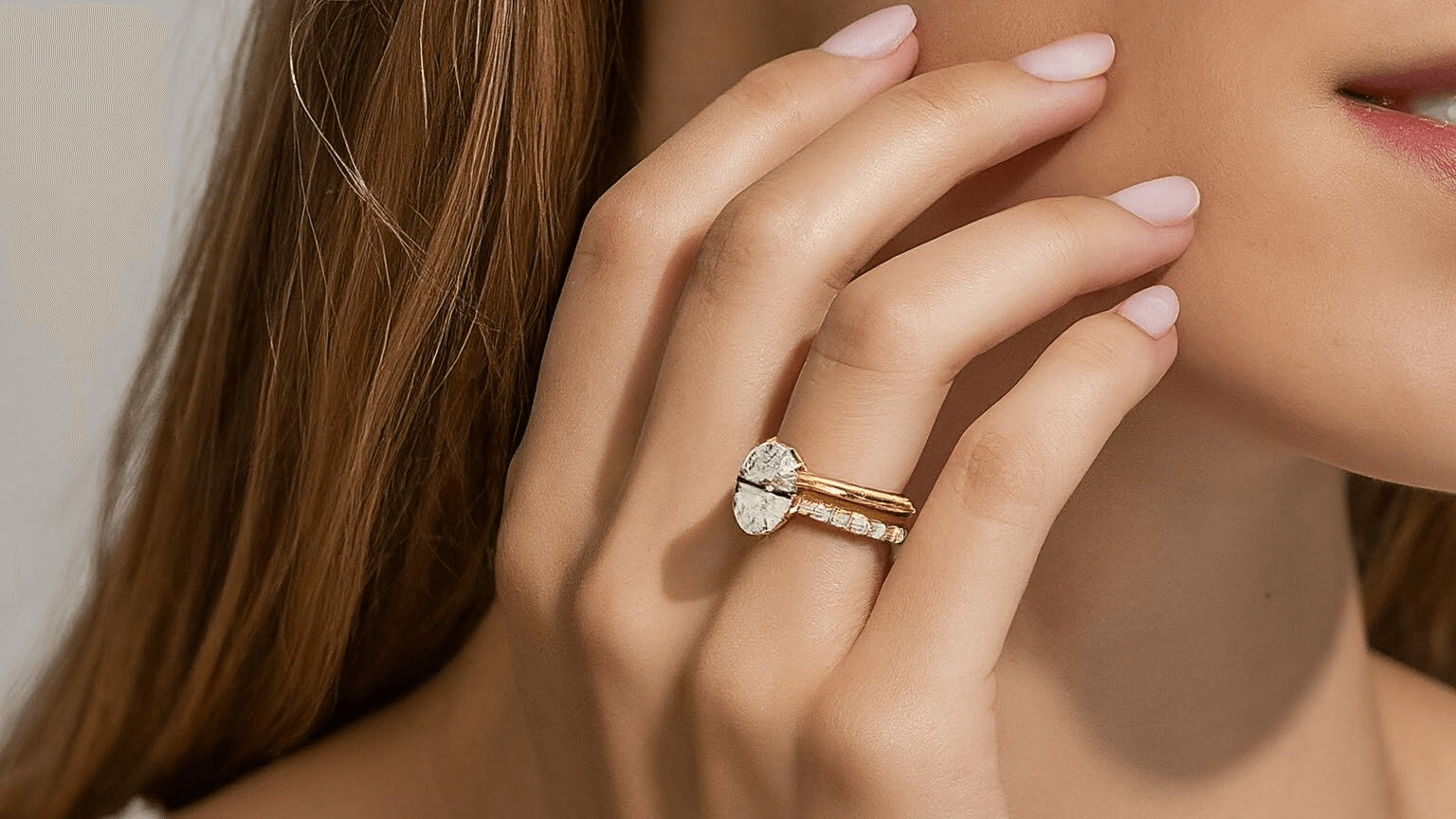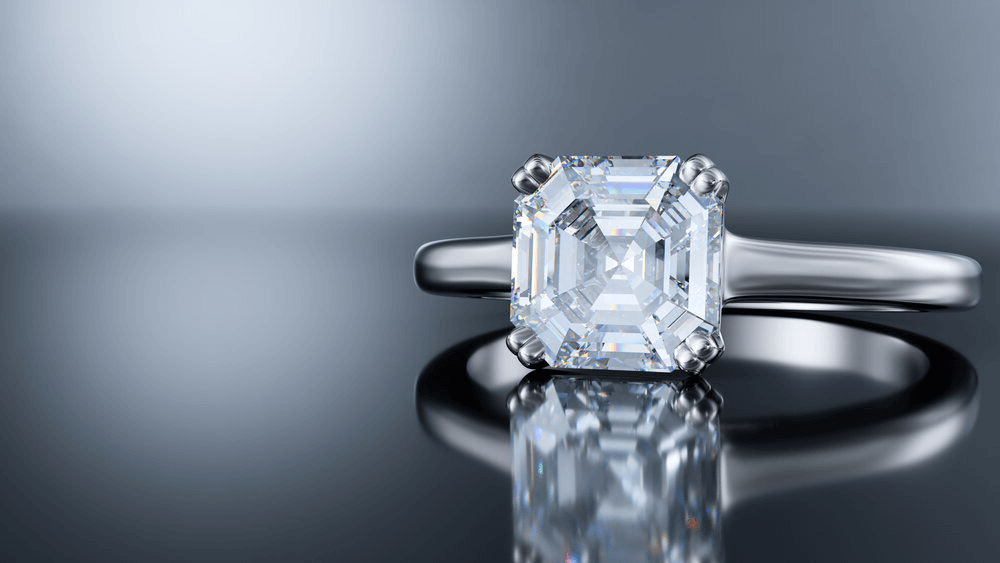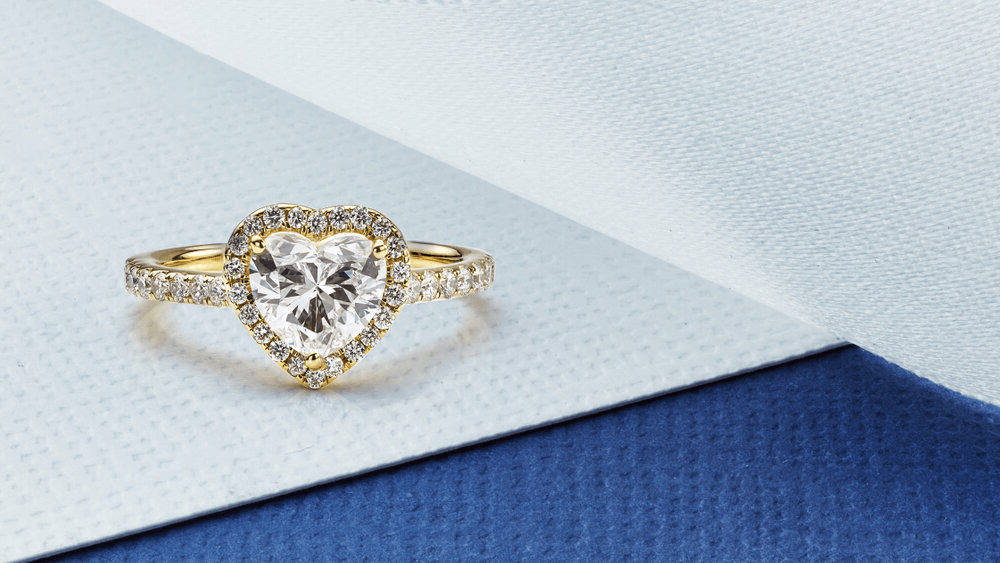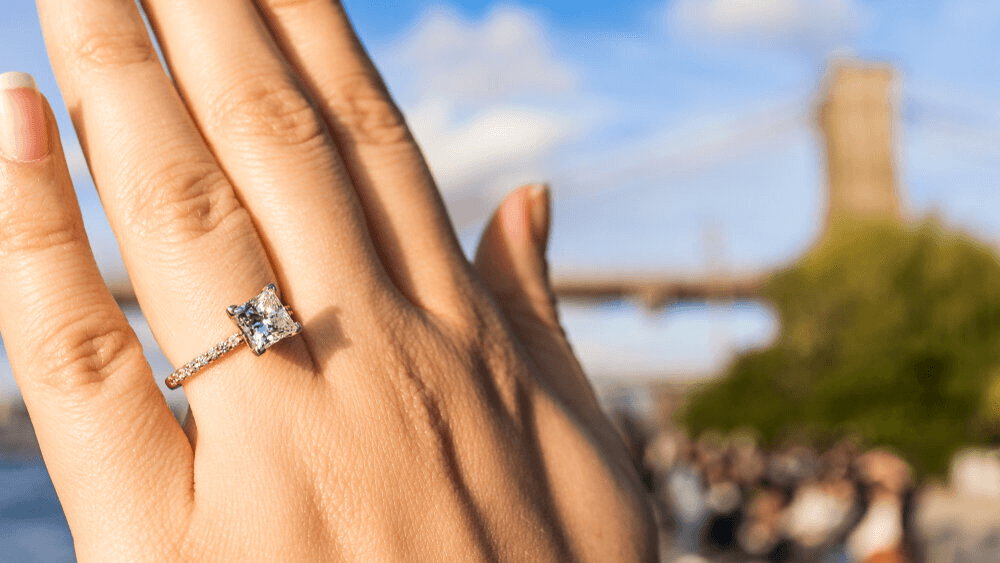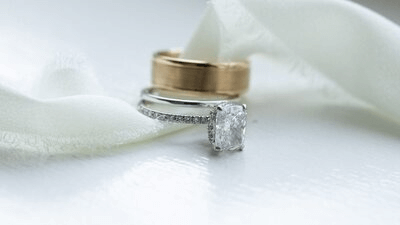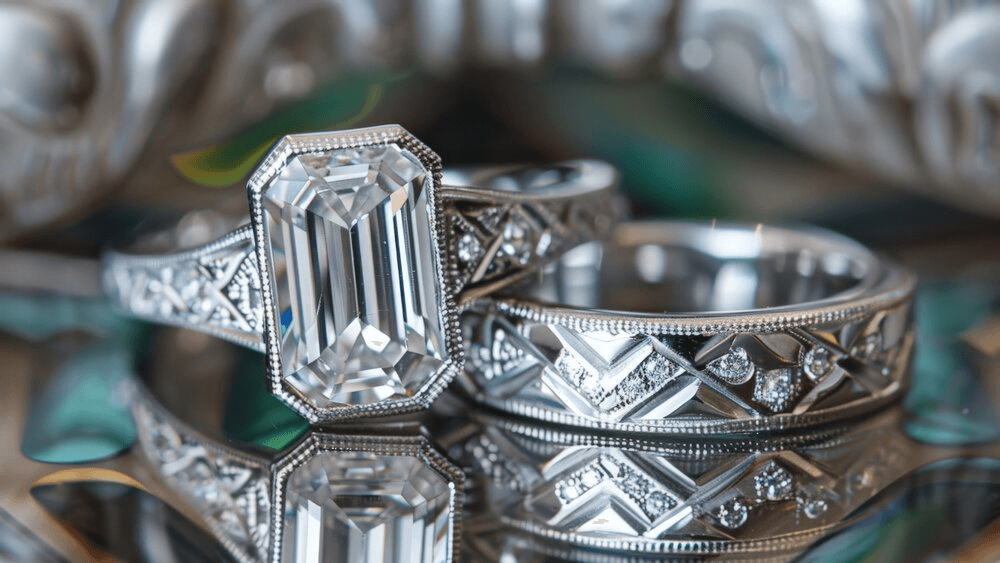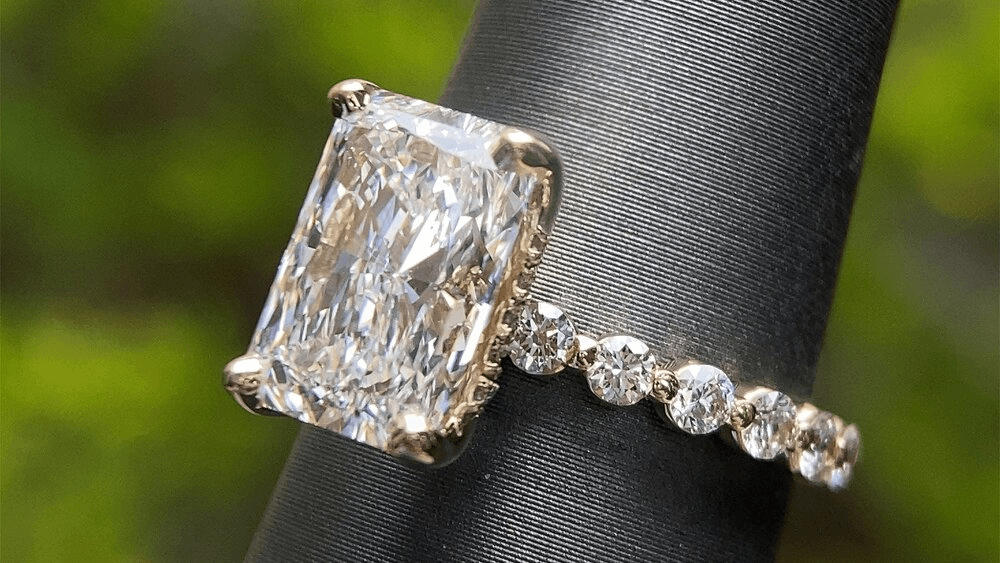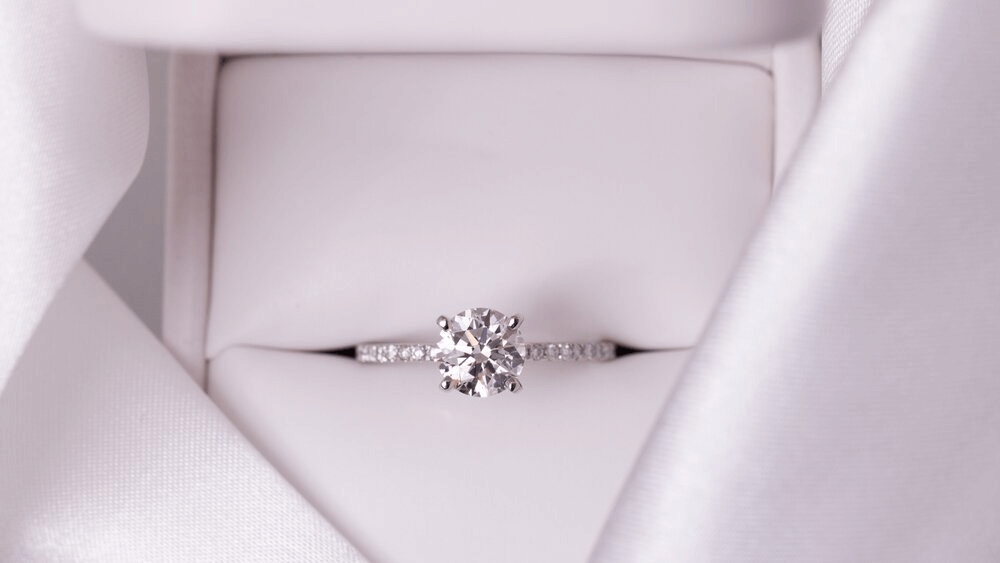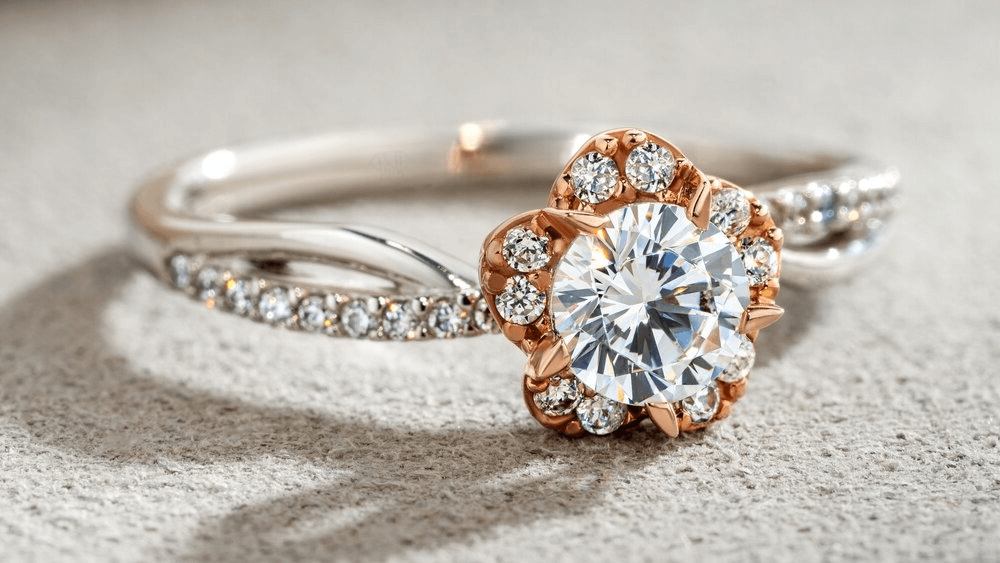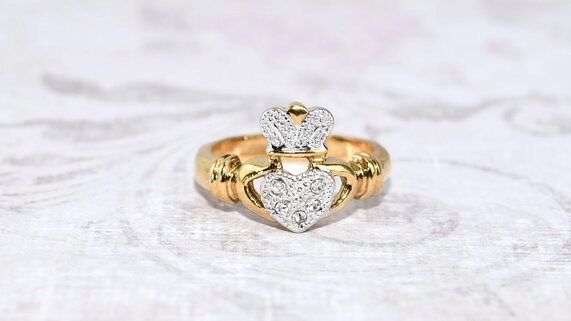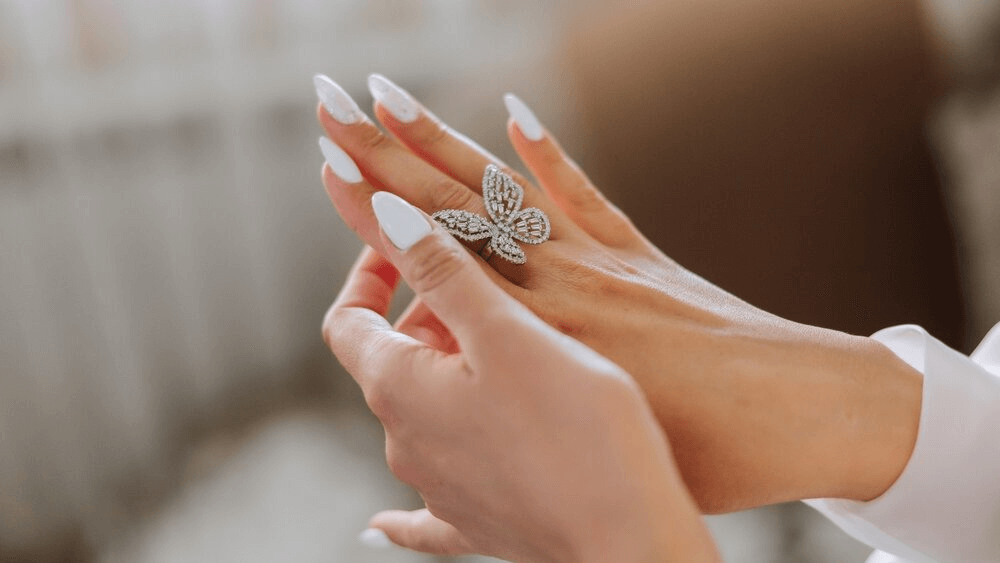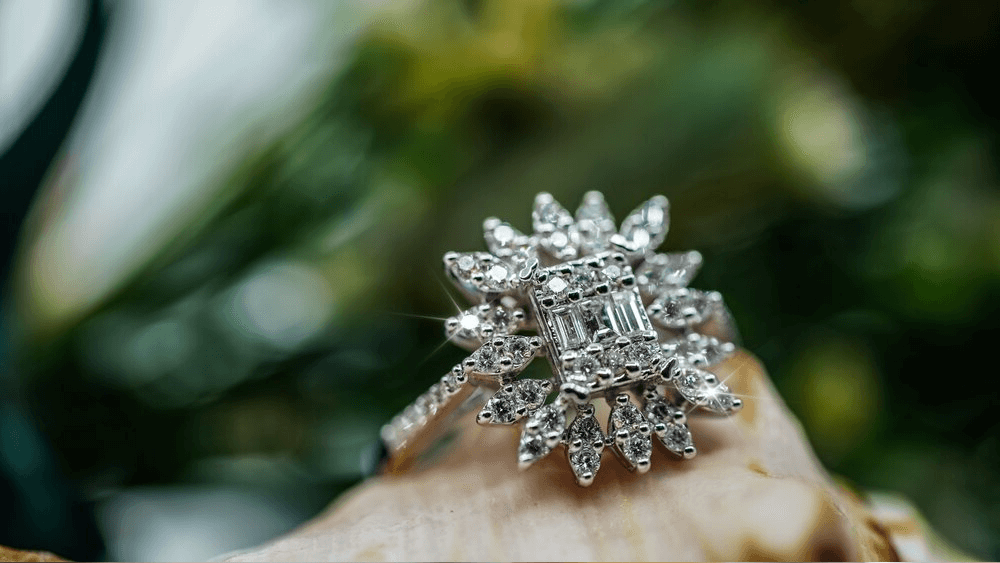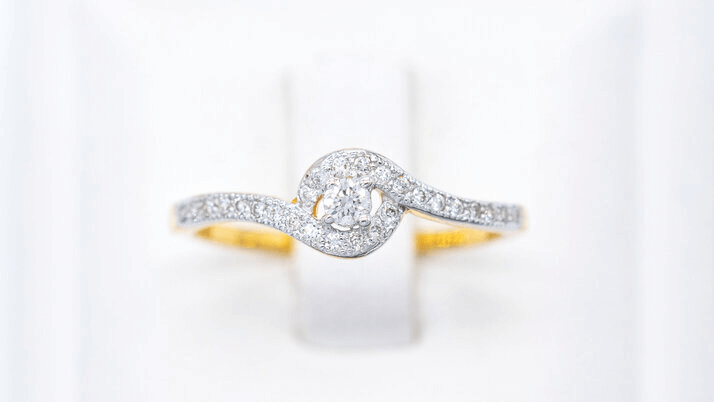Flush Setting Rings: A Modern Bride’s Guide to Elegance

By Gary A.

Edited by Olivia H.
Published Aug 17, 2021
Edited on Dec 18, 2024
A flush setting engagement ring combines sleek minimalism with maximum security, making it a perfect choice for those seeking understated elegance without sacrificing durability.

Navigate This Guide:
- 7 Quick Tips for Buying a Flush Setting Engagement Ring
- Introduction
- What is a Flush Setting Engagement Ring?
- Historical Charm of Flush Settings
- Understanding Diamond Sparkle in Flush Settings
- Choosing the Right Diamond Shape
- The Practicality and Durability of the Flush Setting
- Flush Setting vs Flush Fit Rings
- Our Expert Take
- 8 FAQs
Before we dive deeper into the specifics, here are some practical tips to help guide your decision-making process:
7 Quick Tips for Buying a Flush Setting Engagement Ring
- Tip 1: Understanding the Flush Setting Gain Clarity on the Setting Style: A flush setting, also known as a gypsy setting, embeds the diamond within the band. Recognize that this style is characterized by its sleek, embedded appearance, where the diamond sits flush with the surface of the band.
- Tip 2: Assessing the Diamond’s Visibility and Sparkle Evaluate the Sparkle: In a flush setting, only the top of the diamond (the table) is exposed. This reduces the stone’s sparkle compared to prong settings. When selecting your diamond, consider how it looks in different lighting conditions to ensure it meets your expectations for shine and brilliance.
- Tip 3: Prioritizing Durability and Lifestyle Suitability Consider Lifestyle Compatibility: Flush settings are ideal for active lifestyles or professions that require using your hands. Their design minimizes the risk of the diamond snagging on clothing or equipment, making them a durable choice.
- Tip 4: Matching the Band and Diamond Choose the Right Band Width: The band’s width in a flush setting can influence the ring’s overall look. A wider band can make smaller diamonds appear more integrated, while narrower bands may suit larger diamonds. Ensure the proportion between the band and the diamond is harmonious.
- Tip 5: Opting for Quality Metals Select High-Quality Metals: The metal quality in a flush setting is crucial, as it needs to securely hold the diamond. Opt for stronger metals like platinum or high-grade gold to ensure the setting remains intact and the diamond stays secure over time.
- Tip 6: Analyzing the Diamond Cut and Shape Choose an Appropriate Diamond Cut: Not all diamond cuts are equally suitable for flush settings. Flatter cuts like emerald or asscher may work well, while deeper cuts like round or princess might not sit as neatly within the band.
- Tip 7: Ensuring Comfort and Fit Comfort Is Key: Due to the unique nature of flush settings, the ring’s comfort on the finger is vital. Try on different ring profiles and thicknesses to ensure the ring feels comfortable for everyday wear, keeping in mind that flush settings can sometimes have thicker bands.
Now that you’ve got these practical tips, use Jeweler AI below to find the perfect engagement ring that suits your style and budget:
Introduction
Sometimes, the greatest impact is made with the simplest of designs – even when it comes to engagement rings and wedding jewelry.
Just like the simple and unadorned solitaire engagement ring remains a staple of the world of bridal jewelry, the flush setting also demonstrated quite how much beauty can be achieved when decoration and intricacy are thrown out the window, and replaced by an impression of effortlessness.
That’s not to say that the flush setting is simple to make. The lack of embellishment on this style of ring means that the wearer’s eye would be easily drawn to any tiny mistakes, which means that it takes a lot of skill and attention to detail to keep metal worked so hard looking so untouched.
Still, as far as engagement rings go, the flush setting remains pretty divisive. If you’re inexplicably drawn to this design, there are a few things you ought to know about it first…
What is a Flush Setting Engagement Ring?
A flush setting refers to a band that has had one or more diamonds embedded within the metal, so that the tops of the diamonds are ‘flush’ with the smooth, polished surface of the band.
While the effect is sleek, simple, and minimalistic, actually creating a flush setting is pretty complex stuff. The jeweler has to create a hole in the metal – no easy task when you’re working with something as precious as gold, or as resilient as platinum or tungsten – then add the diamond, and rework the metal until it creates a lip over the very edge of the diamond in order to keep it secure.
This lip also needs to be incredibly even, or the diamond won’t sit flush with the metal and the striking impact of the ring will be lost.
As a result, the flush setting is a great representation of both strength and delicacy. The jeweler has to go pretty tough on the materials they’re using, without leaving any sign of their struggle behind.
This is a bold choice, primarily for the fact that, in a flush set ring, the band itself is the main focus. If your bride-to-be is a minimalist at heart, however, then a flush setting engagement ring or wedding band could be the perfect choice.
This setting is also very popular among men looking to add a little something extra to their band, without going overboard. It gives the perfect opportunity to make a statement in a way that doesn’t try to revolutionize the more traditional design of the groom’s wedding ring.
Historical Charm of Flush Settings
Way back in the Victorian era, lords and noblemen with jewels to protect from highway robbers would choose to embed their diamonds deep within gold and other precious metals, in an attempt to hide their wealth.
We can’t say for sure whether or not it worked, but it is fascinating to think that this particular design – a design that seems to screen modernity and stylishness – has been around for two hundred years or more.
This design also goes by a number of different names, such as belcher ring, ‘shot’ or flush mount setting – or., because of the unique way the jeweler has to position the metal over the very edge of the diamond, the hammer style setting.

Understanding Diamond Sparkle in Flush Settings
With a flush setting, you will still experience a fair amount of sparkle from your diamond, but nowhere near as much as you would if the same diamond were set in a way that exposed more of it to the light source.
The top of a traditional round cut diamond is typically known among jewelers as the table. Where it widens is known as the crown, while below that you will find the pavilion, and the sharply pointed cutlet is at the bottom of the diamond. There are many different ways light can enter a diamond, and the interplay of light entering and exiting through the table, crown, and pavilion is what makes it sparkle so distinctively.
Why is this important? Because, in a flush setting, only the table of the diamond is exposed to the light. It will glimmer and flash when the light hits, but that diamond won’t behave anywhere near its full potential since a large percentage of it remains buried in metal.
This is definitely something to consider, especially if you’re investing thousands into your diamond. It’s a similar issue posed to those interested in the bezel setting since, again, a large part of the diamond is buried from any potential life sources.
There’s nothing wrong with dimming your diamond’s sparkle, so don’t let that deter you – take a look at a few of these rings on our online store and see what you make of that modest shine.
Choosing the Right Diamond Shape
Any diamond cut can be used within the flush setting, although keep in mind that cuts offering less sparkle will be even more muted within this design.
Round, fancy, or step cuts all create significantly different effects when embedded within the metal. The effect can be very striking or very subtle, depending on the size of the diamond compared with the size and thickness of the band – and how the cut reacts within the metal.
For this reason, it’s worth putting a lot of thought into your choice of metal – or mixed metals. Diamonds set within yellow gold can take on a warmer hue – particularly when there is more contact between the metal and the gemstone – whereas diamonds set in white gold or platinum will seemingly shine a little brighter, thanks to the crisp, white shine of these precious metals.
This impacts all diamonds, no matter what ring they are placed in, but much more noticeably in flush or bezel settings, where the diamond remains level with the band.
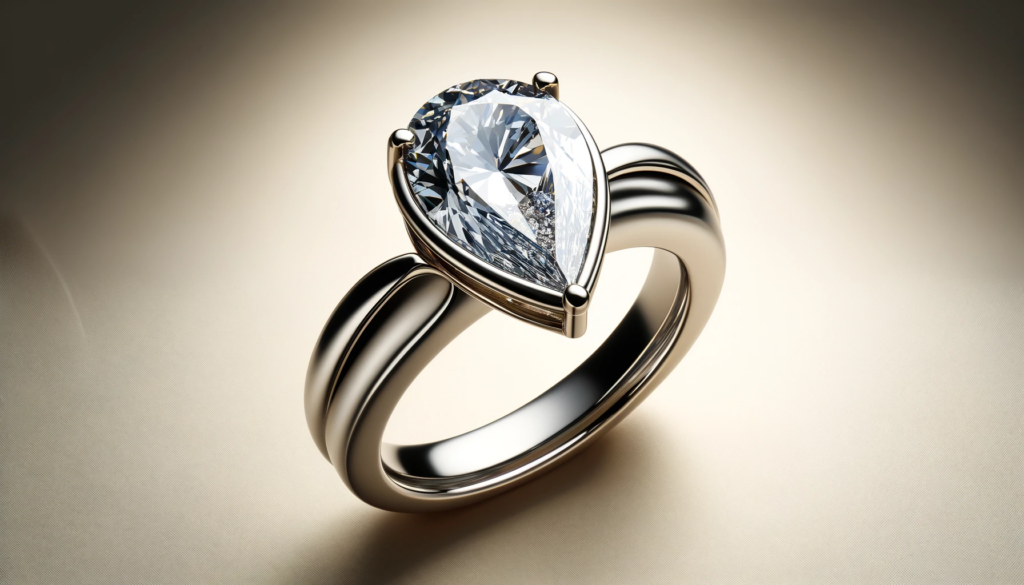
The Practicality and Durability of the Flush Setting
The flush setting is very secure – in fact, probably one of the most secure ring settings you could choose, and an excellent option for anyone who leads a busy life, and is worried about the damage that might do to a more delicate ring style.
We’re not saying that the Victorian noblemen were on the right track when it came to protecting their precious jewels on the highways, but there are definitely plenty of practical advantages to choosing this setting over some of the more ornate options.
With a skilled jeweler behind it, a flush setting engagement ring will be incredibly secure, and the diamond is very unlikely to work itself loose or fall out.
Similarly, it’s much less likely to get chipped or scratched, since no part of the diamond is exposed to the knocks, bumps and scrapes that more prominent settings go through each and every day.
If you or your partner has a physically demanding job, for instance, then the flush setting is absolutely something to keep in mind.
Flush Setting vs Flush Fit Rings
When a ring is described as being flush fit, it typically means that it has been specifically designed to fit perfectly against another ring – in this instance, an engagement ring and a wedding band.
This is not to be confused with a flush setting, although they sound pretty similar.
Some rings and setting styles make it difficult to get that flush, comfortable fit when worn alongside a wedding band. For instance, finding wedding bands for halo engagement rings, which are much bulkier and more ornate than a flush setting, can be tricky, but it is still possible to create a flush fit between the two pieces.
Our Expert Take
This is one of those styles we would urge our readers to exercise plenty of caution over. It’s a memorable and eye-catching style, but that may not be for the reasons your bride-to-be would like.
Love it or hate it, there’s no hiding from the fact that the flush setting is about as far as you can get from the traditional style of engagement ring – that sparkling, prominent diamond that first pops into our heads when we think of proposals and blushing brides.
Flush setting engagement rings are pretty rare. Are they impossible to get your hands on? No – not at all – but just because you can, doesn’t mean you should.
If you love the design but have any qualms over whether or not your intended will feel the same way when you’re down on one knee and opening that ring box for the first time, then consider putting on the back burner until the time comes to pick out your wedding rings.
The flush setting is a versatile design for brides or grooms and offers a great opportunity to incorporate a little something extra into your wedding band without pushing the boat out too far. Use this setting with caution, take a good long look at styles featuring this design when you look through our store, and work out the best way for you to incorporate this technique into your wedding set.
8 FAQs
- Q: What is a Flush Setting Engagement Ring?
- A: A flush setting engagement ring features a diamond or gemstone set into the band, so it sits level with the ring’s surface. This gives the ring a sleek, seamless look.
- Q: How Does a Flush Setting Affect a Diamond’s Sparkle?
- A: A flush setting can reduce a diamond’s sparkle since less of the diamond is exposed to light. Only the top surface (the table) of the diamond catches light, leading to a more subdued sparkle compared to prong settings.
- Q: Is a Flush Setting Engagement Ring Suitable for an Active Lifestyle?
- A: Yes, flush setting rings are ideal for those with active lifestyles. The design minimizes the risk of the diamond catching on clothing or other objects, making it a durable and practical choice.
- Q: Can Any Diamond Shape Be Used in a Flush Setting?
- A: While most diamond shapes can be used, some are more suitable than others. Flatter shapes like emerald or oval cuts may fit more seamlessly into the band compared to deeper cuts like round or princess.
- Q: Are Flush Setting Rings More Secure?
- A: Yes, flush settings are generally more secure because the diamond is embedded into the band, reducing the risk of it loosening or falling out.
- Q: How Do I Care for a Flush Setting Engagement Ring?
- A: Care for a flush setting ring as you would any fine jewelry. Regular cleaning and avoiding harsh impacts will keep the ring looking its best. It’s also wise to have it checked by a jeweler occasionally to ensure the setting remains secure.
- Q: Can Flush Setting Rings Be Resized?
- A: Resizing flush setting rings can be more challenging than other styles, especially if diamonds encircle the entire band. It’s important to get an accurate size before purchasing, but slight resizing is often possible.
- Q: Is a Flush Setting More Expensive Than Other Settings?
- A: The cost of a flush setting can vary, but it is not necessarily more expensive than other settings. The price depends on the metal used, the size and quality of the diamond, and the complexity of the design.
Discover your perfect elongated cushion cut with Jeweler AI – your personalized path to an exquisite engagement ring.
FOLLOW-UP GUIDE SERIES





